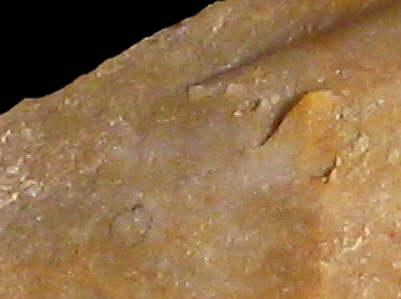
Foto: Jehanne Féblot-Augustins, 2005.
- Chenavel-Château
Sampled sites:
| Material name: | CN8a |
| Synonyms: | Silex Crétacé supérieur Nord - Sénonien (Campanien) |
| Material (geologic): | Late Cretaceous (Campanian, Senonian) flint |

Foto: Jehanne Féblot-Augustins, 2005. |
Sampled sites:
|
| Mode of occurrence: | A single large regular nodule. |
| Cortex: | Thin (<1 mm), smooth and worn, transition gradual. |
| Colour: | Pale brown, putty-coloured (10YR 6/3). |
| Pattern: | Featureless. |
| Appearance: | Homogeneous material, dull and opaque, dry and quite rough, medium-grained. |
| Structure: | No particular structure. |
| Texture: | Wackestone. |
| Matrix: | Opaque. |
| Grains: | 15 to 30 % depending on the areas, rounded and irregularly shaped, pale or stained yellow by iron oxides, well sorted (125 µ). |
| Grain composition: | Numerous sponge spicules, an arthropod, very globose planktonic foraminifera, biserial benthic foraminifera; detrital quartz, irons oxides. |
| Further information: | Click here for the original French description (opens in a new window), or here for more information on the attributes used in the description (use your browser's "BACK"-button to return here). |
| Citing: | Information on citing this page can be found here. |
| Locality: | Jujurieux / Chenavel - Château 2, France, Ain department |
| Synonyms: | Sampling site Bugey 66 after Féblot-Augustins |
| Geographical description: | The material was collected along the GR 59 long-distance footpath near the castle of Chenavel, which lies between the hamlet of Chenavel and the N 84 road, overlooking the river Ain, between Poncin and Pont-d'Ain. |
| Geographical co-ordinates: |
east/x 835.95 north/y 2123.1 (Lambert zone II, NTF)
This corresponds roughly with |
| Co-ordinate precision: |
The French coordinates of the national Lambert-grid were read from an detailed topographical map. We calculated the geographical coordinates by transforming those values on the WGS84 ellipsoid. The location can be found on the 1:25 000 topographical map sheet 3130 E of the French Institut Géographique National. |
| Geology: |
The flint here occurs in clays-with-flints of various origins (Early and Late Cretacous), although the silex is clearly of Late Cretaceous (Senonian) age. Map of all sampled localities of Late Cretaceous flint in the Bugey (PDF, 54 KB, opens in new window). |
| Type of source: | Secondary. |
| Other types of flint: | Two other Senonian flints might be found here: CN1a and CN8b. |
thumb.jpg) Foto: Jehanne Féblot-Augustins, 2005 |
thumb.jpg) Foto: Jehanne Féblot-Augustins, 2005 |
| Last modified on: November 15, 2005 |
Contents primarily by: Jehanne Féblot-Augustins |
Comments to: |